Jadual Kandungan
Dr. Ernest Aston Otho (E.A.O.) Travers (1864-1934)
Dirujuk oleh

“Dr Ernest Aston Otho Travers.” (Arkib Negara 2001/0022889W, 12/08/1887: |"DR. E.A.O. TRAVERS, SELANGOR STATE SURGEON, N.D.").
Kronologi
Bahagian Pertama (1864-1919)
1864: Dr Travers dilahirkan pada tahun 1864 di England. Ibunya Henrietta A D Travers (1829-1871, berkahwin 1852), dan beliau salah seorang daripada 8 orang adik beradik: “Henrietta A D Travers was born in 1829. Henrietta married Otho William Travers circa 1852, at age 23. Otho was born in 1817, in Deal, UK. They had 8 children: Ernest Aston Otho Travers , Otho Robert Travers and 6 other children. Henrietta passed away in 1871, at age 42.” (MyHeritage: |Henrietta Travers).
1887: Residency Surgeon Sungai Ujong (Seremban):-
- “Dr Travers came to Malaya in 1887 first as Residency Surgeon at Sungai Ujong (Seremban) in 1887.” (Lim Kean Ghee, 2016: |"THE HISTORY OF MEDICINE AND HEALTH IN MALAYSIA", m.s.64).
- “With the qualifications of M.R.C.S. and L.R.C.P. he became Residency Surgeon, Negri Sembilan, in 1887.” (The Straits Times, 12 November 1934, Page 11: |"DEATH OF DR. E. A. O. TRAVERS"). 1890: Acting Protector of Indian Immigrants and Acting Magistrate (The Straits Times, 12 November 1934, Page 11: |"DEATH OF DR. E. A. O. TRAVERS"). 1891: Residency Surgeon Selangor:- * “He was made Residency Surgeon of Selangor in 1891…” (Lim Kean Ghee, 2016: |"THE HISTORY OF MEDICINE AND HEALTH IN MALAYSIA", m.s.64). * Beliau telah mencadangkan pusat pesakit kusta didirikan berdekatan Pauper Hospital: “When he was Residency Surgeon in 1891, he had recommended an asylum be erected for leprosy patients near the Pauper Hospital.” (Ho Tak Ming, 2000: "Doctors Extraordinare", m.s. 199).
1892: Mengasaskan Selangor Journal, dengan 2 rakan kongsi yang lain:-
- “He started the Selangor Journal with two partners in 1892…” (Lim Kean Ghee, 2016: |"THE HISTORY OF MEDICINE AND HEALTH IN MALAYSIA", m.s.65).
- “In 1892, with two partners, he started the Selangor Journal, a fortnightly periodical devoted to news and views about current events in Kuala Lumpur and other districts of Selangor. The journal ran for four years, until the Malay Mail, the first daily newspaper, began publication in 1896.” (Ho Tak Ming, 2000: "Doctors Extraordinare", m.s. 198).
1894: Health Officer, Kuala Lumpur. (The Straits Times, 12 November 1934, Page 11: |"DEATH OF DR. E. A. O. TRAVERS").
1897: State Surgeon Selangor: “…and State Surgeon in 1897.” (Lim Kean Ghee, 2016: |"THE HISTORY OF MEDICINE AND HEALTH IN MALAYSIA", m.s.64).
1907: Sebagai State Surgeon Selangor, mengumumkan tahap vaksinasi cacar / smallpox yang mencukupi di Selangor: “In 1907, Travers the State Surgeon in Selangor declared that ‘the state may be considered well vaccinated and safe from any smallpox epidemic’.” (Lim Kean Ghee, 2016: |"THE HISTORY OF MEDICINE AND HEALTH IN MALAYSIA", m.s.30).
1909-01-01: Bersara kali pertama:-
- “Dr. Travers who retired from the post of State Surgeon, Selangor, on Jan.1, 1909, but it was not until a few years ago that he decided really to retire and live in Europe.” (The Straits Times, 12 November 1934, Page 11: |"DEATH OF DR. E. A. O. TRAVERS").
1909: Perniagaan dan Perkhidmatan Persendirian: Beliau adalah tokoh komuniti Eropah di Kuala Lumpur, dan bersahabat baik dengan beberapa orang tempatan, termasuk Loke Yew yang menjadi rakan kongsi perniagaannya:-
- “He was said to be the life and soul of the European community in Kuala Lumpur and was a close friend of locals like Loke Yew. He started the Selangor Journal with two partners in 1892 and left government service in 1909 to go into business with Loke Yew and to set up private practice.” (Lim Kean Ghee, 2016: |"THE HISTORY OF MEDICINE AND HEALTH IN MALAYSIA", m.s.64-65).
- “Dr Travers was a close friend of Loke Yew's sharing with him an enthusiasm for the newly introduced novelty of motoring, and in 1909 he left government service to go into business with Loke Yew, and to set up private practice. … A keen sportsman, he often went big game hunting with Capt. HC Syers, the Commissioner of Police. It was said that he once shot a tiger in the middle of Kuala Lumpur.” (Ho Tak Ming, 2000: "Doctors Extraordinare", m.s. 198).
Ketika berkhidmat sebagai doktor persendirian, beliau berjaya membuat pembedahan di rumah pesakit yang tak dapat bergerak, dengan mengarahkan bumbungnya dibuka agar cukup pencahayaannya ketika itu:-
- “Dr Ernest Travers, who started private practice in Kuala Lumpur in 1909, once did an emergency operation in the home of a patient (with an assistant to give the anaesthetic) whom he found too ill to be moved. Because there was inadequate light for the operation, he ordered the roof to be removed. The operation was reportedly successful.” (Lim Kean Ghee, 2016: |"THE HISTORY OF MEDICINE AND HEALTH IN MALAYSIA", m.s.73).
- “There is a story about Dr Travers. He was notified that a woman outstation was very ill and probably needed an operation. Accompanied by an assitant to give the anesthetic, he drove over to the place as quickly as possible. On arrival, he found the woman too ill to be removed, and decided to perform the operation on the spot. There was, however, insufficient light in the attap hut. Travers glanced around and asked for part of the roof to be removed. 'But it may rain', remonstrated the owner. 'Never mind', said Travers, 'we can risk that,' So part of the roof was pulled off and a successful operation performed. Luckily there was no rain. Over and over again his simple presence in a sick room acted like a tonic on his patient. He was a charitable man, and 'attended the rich and poor with equal attention, and very often did not charge the poor at all'. He was the moving spirit behind the Samaritan Society, which provided nursing care and 'comforts' to the sick for only $1 a day.” (Ho Tak Ming, 2000: "Doctors Extraordinare", m.s.198-199).
Setelah berjaya mengumpul harta, beliau kembali ke England: “There was a boom in Kuala Lumpur consequent to its being made the Federal Capital in 1896, and Dr Travers soon made a sizeable fortune.” (Ho Tak Ming, 2000: "Doctors Extraordinare", m.s.199)
1911-1919: Terlibat dalam Perang Dunia Kedua: “Dr. William Fletcher, who at one time served under him, writes in the London Times that Dr. Travers went to Malaya in 1887 and was soon assigned State Surgeon in Kuala Lumpur, where he lived until he finally retired in 1925, with the exception of the period from 1911 until 1919 during which he served in the Great War.” (International Journal of Leprosy and other Mycobacterial Diseases, Vol. 3 N° 2 - Apr/May/Jun - 1935: |"Leprosy News", m.s.7).
Beliau mengalami kerugian pula di London Stock Exchange, khabarnya akibat kejatuhan harga getah. Beliau kembali ke Malaya selepas Perang Dunia Pertama: “He was able to retire to England, hoping to double his fortune on the London Stock Exchange, and to indulge in his favorite pastime of big game hunting in East Africa. On the contrary he quickly lost the lot. When Loke Yew heard about his friend's plight, his laconic comment was, 'Bodoh dia, London bukan Kuala Lumpur.' However, such was his generosity that he helped to set his friend on his feet again.” (Ho Tak Ming, 2000: "Doctors Extraordinare", m.s.199)
Bahagian Kedua (1922-1934)
Sementara itu, di Tanah Melayu, akibat penyisihan penghidap kusta di kalangan masyarakat, pihak kerajaan telah menggubal Akta Kusta pada tahun 1926, di mana semua penghidap kusta dipindahkan ke beberapa pusat pesakit kusta di serata negara, seperti Pulau Jerejak, Tampoi, dan Setapak: “In the 1920s, leprosy was still an incurable disease and was so dreaded that the leprosy sufferers would try really hard to keep their condition secret by way of hiding. If a child has contracted leprosy, his family would pull him out of school and keep him at home. As a measure to prevent the spread of leprosy, the British government enacted the Leper Enactment Act in 1926, which mandated the notification and segregation of leprosy patients in Malaya. Once a patient was found to have contracted leprosy, they would be taken away to one of the various leprosy camps in the country, such as the Penang’s Pulau Jerejak, Johor’s Tampoi; and Selangor’s Setapak, amongst other places.” (Chan Wei See @ Care & Share Circle: |"Management of the Valley of Hope").
1922-1925: Senior State Medical and Health Officer, Selangor. Beliau mendapati pusat pesakit kusta yang dicadangkan beliau pada tahun 1891 dahulu telah menjadi seperti penjara, lalu berusaha mengubahnya menjadi persekitaran yang baik:-
- “He returned to Malaya after the First World War and it was his work as Senior State Medical and Health Officer from 1922 that he left his mark. He transformed the care of leprosy patients first at Setapak and he laid the groundwork for the Sungai Buloh Settlement.” (Lim Kean Ghee, 2016: |"THE HISTORY OF MEDICINE AND HEALTH IN MALAYSIA", m.s.65).
- “…this asylum turned out to be more like a prison, where leprosy patients were forcibly incarcertated, out of sight of the public, who had a horror of it. It was a disease of the downtrodden, of the Chinese coolie and Indian convict.” (Ho Tak Ming, 2000: "Doctors Extraordinare", m.s.199).
- “Life in the asylum was “a dull and depressing business, as it would inevitably be among a community carrying out what was practically a life sentence without employment or amusement”.³ Many were sent and forcibly confined there by the police or medical personnel as part of the colonial government’s segregation policy. … Travers was also concerned with the mental well-being of the patients and wanted to “make a home for them, in which they will be happier” and “where they can be employed and where a reasonable hope of cure can be held out to them”.⁶ He believed that a healthier, more humane environment could bring about better outcomes and had the asylum transformed into a small town. As the patients began to improve rapidly in their physique and general health, many became employed for various work such as gardeners, cooks, carpenters and masons. There were even entertainment and recreational activities organised by the patients themselves. Under Travers, the asylum became a place where the “lepers no longer felt the utter misery and desolation of being both diseased and outcast”⁷ and more people with the disease admitted themselves voluntarily into Setapak. Travers’s wish to improve the conditions of segregation also led to the idea of a self-contained settlement more like that of life in a camp. This idea came to fruition with the construction of the Sungai Buloh Settlement for leprosy patients in a lush valley north of Kuala Lumpur.” (National Library Singapore, Sep 29, 2021: |"[We Like It Rare] Tai Foong Chee — A Traditional Chinese Remedy for Leprosy in Western Medical Practice").
- “When Dr Travers was appointed Senior State Medical and Health Officer in 1922, he took charge of the Setapak Camp and took an interest in the treatment of the disease with “Tai Foong Chee”. He also went about addressing social problems and provided more humane surroundings. In a short period of time, instead of having to prevent lepers from escaping, the problem became how to house those who came, from all parts of the country, for the new treatment.” (Lim Kean Ghee, 2016: |"THE HISTORY OF MEDICINE AND HEALTH IN MALAYSIA", m.s.64).
- “Financially depleted by the rubber slump, he obtained a minor post in the service of which he had been the head for years before his first retirement, and was placed in charge of the old leper asylum near the town where some 400 people living under deplorable conditions. These conditions were soon corrected, the terribly high death rate fell to a quarter of its previous magnitude, and the spirit of hopelessness and apathy was dispelled, but Dr. Travers greatly desired to see these people removed to a suitable settlement elsewhere.” (International Journal of Leprosy and other Mycobacterial Diseases, Vol. 3 N° 2 - Apr/May/Jun - 1935: |"Leprosy News", m.s.7).
- “The old Leper Asylum was not a very admirable institution before Dr. Travers took charge of it in 1922. “There was little, if anything, done for the inmates once they were arrested and placed behind the iron fence,” declared one writer….The place was a Village of Disease, Dread and Despair. Today it is a Village of Hope and Happiness.” The doctor set himself energetically to induce cheerfulness in the patients and see them supplied with modest comforts, previously wholly lacking; and with determination and skill he devoted countless hours to investigation of the dread disease itself, with splendid results in improved methods of treatment. He also interested himself in the care of lepers' children.“ (The Straits Times, 12 November 1934, Page 11: |"DEATH OF DR. E. A. O. TRAVERS").
Dr Travers turut mengamalkan perubatan Cina “Tai Foong Chee” ketika mengelola kem kusta di Setapak:-
- “From 1922, when he was in-charge of the leprosy camp in Setapak, Dr Travers used and studied “Tai Foong Chee” for treating leprosy for lack of any other effective treatment. Clinical results were recorded and modification to the mixture was experimented with.” (Lim Kean Ghee, 2016: |"THE HISTORY OF MEDICINE AND HEALTH IN MALAYSIA", m.s.21)
- “His name is perhaps best known to leprosy workers because of his tai fong tsi treatment, in which he adapted three native Chinese medicaments - one of them the chaulmoogra seed - in a meal-like preparation which taken by mouth and which he found decidely beneficial.” (International Journal of Leprosy and other Mycobacterial Diseases, Vol. 3 N° 2 - Apr/May/Jun - 1935: |"Leprosy News", m.s.7).
- “Published together as a set in 1925, the two pamphlets were titled The Tai Foong Chee Treatment of Leprosy and The Results of the Tai Foong Chee Treatment. Interestingly, the author, Dr Ernest Aston Otho Travers, was a medical officer with the British colonial service and a physician trained in the Western tradition. Travers demonstrated the effectiveness of traditional medicine from other cultures through scientific assessment and the encouraging results attracted attention from medical communities beyond Malaya. … In April 1922, the Kuala Lumpur Leper Asylum (also known as Setapak camp), which housed around 300 patients, came under his charge until his retirement in 1925, the same year in which the two pamphlets were published. The first pamphlet contained several tables of statistics setting out the trial results of the Tai Foong Chee treatment administered to the patients in Setapak camp and the second pamphlet contained photos showing the outcome of a year’s treatment. … While segregation was critical from a public health perspective, Travers was of the view that the asylum could be a place of hope for a cure. In 1922, a few remedies were tested: one of which was the injection of chaulmoogra oil from Hydnocarpus wightiana, or Chaulmoogra seeds, but the results were inconsistent. It came to Travers’ attention that nine Chinese leprosy patients had presented no visible signs of the disease. Five of these were subsequently assessed and cleared of the leprosy bacilli by the Institute for Medical Research. Travers discovered that they had been self-medicating with a Chinese formula consisting of a blend of three ingredients: Tai Foong Chee (Hydnocarpus anthelmintica or Chaulmoogra nuts), Pak Chut Lai (Tribulus terrestris Linn or Puncture Vine seeds) and Foh Mah Yan (Cannabis indica or Hemp seeds). The Chinese had used this remedy as a cure for leprosy for many years. He was impressed by the remarkable results and proceeded to place more patients on the treatment. This inexpensive treatment of just three pence per patient per month was so simple that the patients could handle the process from preparation to administration on their own. Travers noted that “the Chinese lepers have become so extraordinarily quick and efficient at this work that over three hundred and fifty doses are given and registered in under half an hour”.⁴ It was effective, had relatively fewer undesirable side effects and so “very popular with the lepers, women and children taking it as regularly as the men, and it is not often that any of them miss a dose”.”
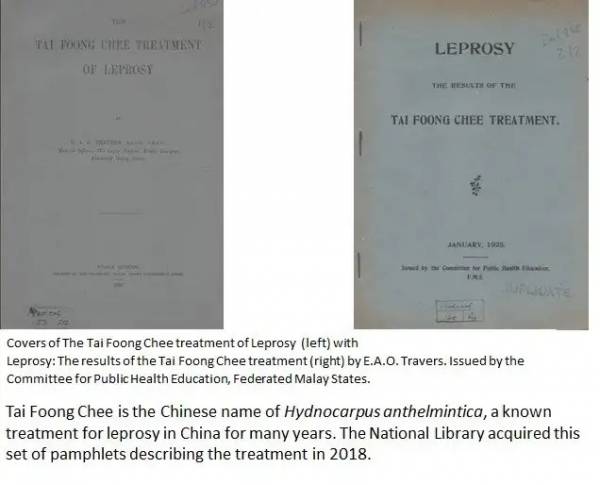
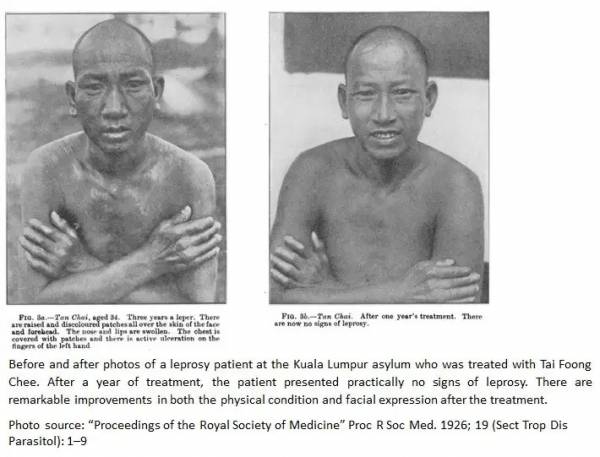
(Sumber: National Library Singapore, Sep 29, 2021: |"[We Like It Rare] Tai Foong Chee — A Traditional Chinese Remedy for Leprosy in Western Medical Practice").
1923: Membentang kertas kerja di Kongres Perubatan Tropika, yang antara lain mencadangkan sebuah kampung khas buat pesakit kusta yang dilengkapi kemudahan hospital dan perubatan mereka, serta mempunyai kawasan untuk bercucuk tanam. Ini merupakan bayangan awal kampung pesakit kusta di Sungai Buloh, yang didirikan pada tahun 1930:-
- “In 1923, at the 5th Biennial Congress of Tropical Medicine held in Singapore, he introduced the idea of a “self-supporting community.” 2 His bold and forward-thinking vision was materialised by Dr Gordon Ryrie, the first Medical Superintendent of the Sungai Buloh Settlement.3 The Valley of Hope, officially opened on 15 August 1930, was then the largest and best-equipped leprosarium in the British Commonwealth.” (Chan Wei See @ Care & Share Circle: |"Management of the Valley of Hope").
- “Travers also put forward his idea of a site suitable for agriculture with hospital and treatment facilities…a settlement like a ‘kampong’ in a paper at a Congress of Tropical Medicine in 1923. Out of this vision came the Sungai Buloh Settlement which George Maxwell had mooted. Travers retired in 1925, but his dream became a reality in 1930. In August that year, 940 odd patients from the Setapak Camp, including some from the Taiping Centre, which was closed, were sent there.” (Lim Kean Ghee, 2016: |"THE HISTORY OF MEDICINE AND HEALTH IN MALAYSIA", m.s.64).
- “The model village which the government subsequently built for them at Sungei Buloh, 18 miles from Kuala Lumpur, stands as a monument to his devotion.” (International Journal of Leprosy and other Mycobacterial Diseases, Vol. 3 N° 2 - Apr/May/Jun - 1935: |"Leprosy News", m.s.7).
- “The provision of the excellent new Assylum at Sungei Buloh was largely due to him.” (The Straits Times, 12 November 1934, Page 11: |"DEATH OF DR. E. A. O. TRAVERS").
- “The leprosarium, believed to be the most modern of its time and then second largest in the world, opened on Aug 16, 1930. Countries like Brazil even modelled theirs after it. … Leprosy was incurable at that time. Many tried to run away, and those who could not relied on government-supplied opium to ease their pain. Seeing that, he proposed that the British government build a more humane leprosarium in Sungai Buloh, at a place then called the Valley of Hope.” (Veena Babulal @ New Straits Times, September 10, 2017: |"These unsung heroes, too, deserve to be included in history books").
Selain itu beliau turut mengasaskan klinik anti-candu di daerah Klang, percubaan pertama di Malaya, dan khabarnya agak berjaya: “By the Asiatics in Selangor he will probably be best and most gratefully remembered for his magnificient services to the Leper Asylum at Sungei Buloh, and for his noble pioneer work in opening an anti-opium clinic in the Klang district - the first experiment of its kind in Malaya. Many drug addicts reported themselves cured after treatment in this little institution.” (The Straits Times, 12 November 1934, Page 11: |"DEATH OF DR. E. A. O. TRAVERS").
“For three or four decades he was the life and soul of the European community here (Kuala Lumpur) - to say nothing of his influence amongst Asiatics. A tabulated list of all his interests - professional, sporting, social, commercial, and financial - would fill columns of a newspaper. He was certainly a mighty hunter of wild animals. - J.H.M. Robson” (The Straits Times, 12 November 1934, Page 11: |"DEATH OF DR. E. A. O. TRAVERS").
1928: Bersara sepenuhnya dan kembali ke England. Sekembalinya di England, beliau aktif sebagai “country squire”, juga ekspedisi memburu di Afrika Timur. Pernah terlibat dalam kemalangan di sana (dilanggar kereta), cedera parah, namun kembali pulih setelah menjalani rawatan di hospital: “His departure for Home in 1928 was a sad blow to the lepers… He now lives at Home in the role of a country squire, and is of course taking an active part in the public life of his locality, when not away on big game shooting expeditions in East Africa. … He met with a serious accident in London a year or two ago, being knocked down by a motor car and gravely injured, but after a long stay in hospital he made a splendid recovery and resumed many of his former activities.” (The Straits Times, 12 November 1934, Page 11: |"DEATH OF DR. E. A. O. TRAVERS").
1934-11-09: Meninggal Dunia:-
- Dr Travers meninggal dunia di England pada 9 November 1934. (International Journal of Leprosy and other Mycobacterial Diseases, Vol. 3 N° 2 - Apr/May/Jun - 1935: |"Leprosy News", m.s.7).
- “The death took place at Saffron Walden yesterday, at the age of 70 years, of Dr. Ernest Aston Otho Travers.” (The Straits Times, 12 November 1934, Page 11: |"DEATH OF DR. E. A. O. TRAVERS").
Peninggalan
Valley of Hope
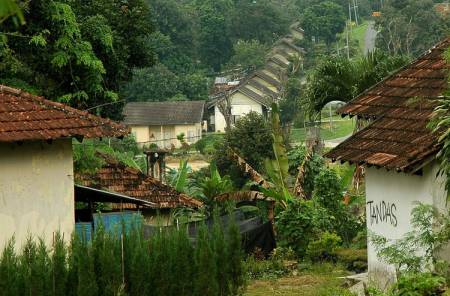
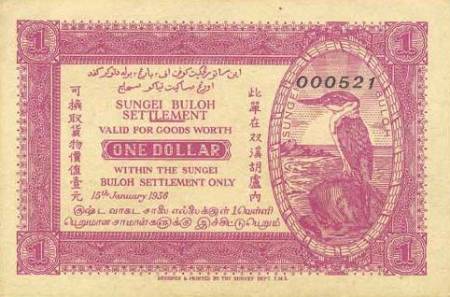
Kiri: “The chalets in Valley of Hope were planned in clusters so virtually it formed a settlement of a village concept. (photo by Dr Lim Yong Long)”
Kanan: “The emblem on the notes was a kingfisher, the early inhabitant of the stream that flowed through the settlement. . (photo courtesy of Sungai Buloh Settlement Council)”
“When Dr Earnest Aston Otho Travers (1865-1934) was serving as a medical officer in the Setapak Leprosy Camp, he saw the poor facilities and the overcrowded, subhuman living conditions in the camp and began to mull about ways to improve the situation. In 1923, at the 5th Biennial Congress of Tropical Medicine held in Singapore, he introduced the idea of a “self-supporting community.” His bold and forward-thinking vision was materialised by Dr Gordon Ryrie, the first Medical Superintendent of the Sungai Buloh Settlement. The Valley of Hope, officially opened on 15 August 1930, was then the largest and best-equipped leprosarium in the British Commonwealth. The 570-acre colony, much like a little country, is a self-contained community and has every facility one can imagine – hospital wards, housing, a marketplace, a school, a community hall, a recreational field, a prison, a mosque, a Hindu temple, Chinese temples, churches, and a variety of clubs and associations. The settlement even introduced its own printed currency for internal circulation.”
(Chan Wei See @ Care & Share Circle: |"Management of the Valley of Hope").
Jalan Travers
“Jalan Travers is a major road in Brickfields, and now in new central business district of KL Sentral in Kuala Lumpur. It originally linked Jalan Damansara to Jalan Tun Sambanthan, but since January 2015, it ends at the junction with Jalan Bangsar. The stretch between Jalan Bangsar and Jalan Tun Sambanthan has been renamed Jalan Rakyat, following the request of Bank Rakyat, which has its headquarters on that road. Originally known as Travers Road, Jalan Travers was named after Dr Ernest Aston Otho Travers1, a doctor who worked among those who were stricken with leprosy at the leper colony in Setapak. Today Jalan Travers is one of three roads named after him, the other two being Lorong Travers and Jalan Bukit Travers.” (Timothy Tye: |"Jalan Travers, Kuala Lumpur").

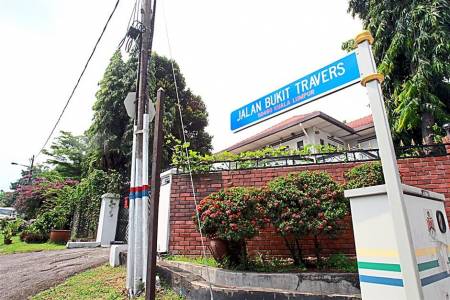
Kiri: “Construction continues along Jalan Travers without any sign of slowing down.”
Kanan: “Lorong Travers and Jalan Bukit Travers try to retain some extent of tranquility behind the busy Jalan Travers. It is said that the streetscape of these two roads have remained unchanged for more than 40 years.”
(Sumber: Yip Yoke Teng, 10 Oct 2014: |"Jalan Travers a mix of old buildings and modern skyscrapers").
2015-01-16: Jalan Travers diubah namanya kepada Jalan Rakyat: “The 300m stretch of Jalan Travers has been renamed Jalan Rakyat, Prime Minister Datuk Seri Najib Razak announced yesterday. The change was announced in conjunction with the launch of Bank Rakyat's new headquarters, known as Bank Rakyat Twin Towers. The road fronts the towers. Jalan Rakyat starts from the intersection of Jalan Tun Sambanthan and ends at the intersection of Jalan . Bangsar and Jalan Travers. Jalan Travers was named after Dr Ernest Aston Otho Travers, the state surgeon of Selangor in the 1890s. He was known to bring reform in the care of leprosy patients in the country. The new Bank Rakyat headquarters, built at a cost RM460 million, consists of two towers built over an area measuring 426,433 square feet (39,616sq m)” (New Straits Times, 16 Jan 2015: |"Jalan Travers is now Jalan Rakyat").
Memoriam
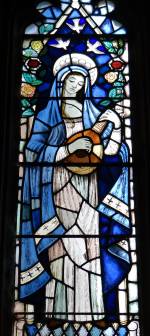
“Mapledurham, Oxfordshire: North aisle, west window, in memory of Dr Ernest Aston Otho Travers (1864-1934), for many years state surgeon at Selangor, Malaya, and his wife Caroline (1873-1958), by grand daughter Jane Ross - Saints Cecilia and Francis” (Rex Haris @ flickr, March 16, 2017: |"Mapledurham, Oxfordshire").
| Laman Utama | Hubungi Kami | ||||||||
| Siri Cebisan Sejarah: | Bangi | Gambang | Hutan | Ipoh | Kajang | Kuala Lumpur | Kuantan | Pulau Pinang | Hubungi Kami |
